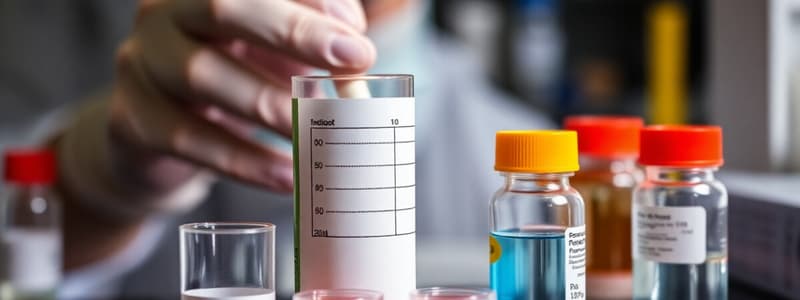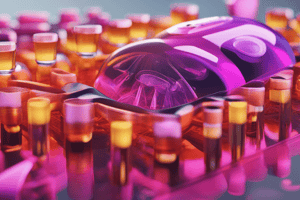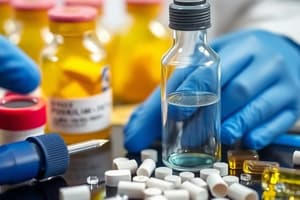Podcast
Questions and Answers
What types of samples does the Toxicology Section analyze?
What types of samples does the Toxicology Section analyze?
- Biological samples and beverages (correct)
- Only biological samples
- Only blood samples
- Only beverages
Which types of cases does the Toxicology Section handle?
Which types of cases does the Toxicology Section handle?
- Only drug-related crimes
- DUI/DUID, drug-facilitated crimes, and death investigations (correct)
- Only traffic accidents
- Only alcohol-related cases
What is provided to law enforcement agencies for DUI/DUID cases?
What is provided to law enforcement agencies for DUI/DUID cases?
- Evidence submission forms
- Alcohol testing devices
- Drug testing kits
- DUI/DUID Blood Specimen Collection Kits (correct)
How does the Virginia Department of Forensic Science determine laboratory designation for Blood Specimen Collection Kits?
How does the Virginia Department of Forensic Science determine laboratory designation for Blood Specimen Collection Kits?
What document contains the Uncertainty of Measurement (UoM) statement?
What document contains the Uncertainty of Measurement (UoM) statement?
Is a secondary mailing package necessary for Blood Specimen Collection Kits?
Is a secondary mailing package necessary for Blood Specimen Collection Kits?
Who should be contacted for questions related to toxicology laboratory capabilities?
Who should be contacted for questions related to toxicology laboratory capabilities?
What does the Toxicology Section analyze in beverages?
What does the Toxicology Section analyze in beverages?
What should be done with Part A of the evidence seal?
What should be done with Part A of the evidence seal?
Which part of the evidence seal should NOT have its backing removed?
Which part of the evidence seal should NOT have its backing removed?
What must be done with the CBW after the blood examination is complete?
What must be done with the CBW after the blood examination is complete?
How long will the remainder of the blood sample be preserved by DFS?
How long will the remainder of the blood sample be preserved by DFS?
What should be done if no request to return the evidence is received?
What should be done if no request to return the evidence is received?
What should NOT be done with the CBW?
What should NOT be done with the CBW?
What is the purpose of placing the specimen holder into a plastic bag?
What is the purpose of placing the specimen holder into a plastic bag?
What must be included with the outer container when mailing?
What must be included with the outer container when mailing?
What types of substances can be measured for concentration as mentioned in the collection guidelines?
What types of substances can be measured for concentration as mentioned in the collection guidelines?
Who is permitted to withdraw blood using the DUI/DUID Blood Specimen Collection Kit?
Who is permitted to withdraw blood using the DUI/DUID Blood Specimen Collection Kit?
What must be done to the blood vials before sealing them?
What must be done to the blood vials before sealing them?
What accompanies the DUI/DUID Blood Specimen Collection Kit for documentation purposes?
What accompanies the DUI/DUID Blood Specimen Collection Kit for documentation purposes?
What should be done if the accused is known to have a blood borne disease?
What should be done if the accused is known to have a blood borne disease?
Which of the following is NOT a step in the sample collection process?
Which of the following is NOT a step in the sample collection process?
What is the purpose of the evidence seals included in the DUI/DUID Blood Specimen Collection Kit?
What is the purpose of the evidence seals included in the DUI/DUID Blood Specimen Collection Kit?
What step must be completed regarding the vials during the blood collection process?
What step must be completed regarding the vials during the blood collection process?
What is included in the DUID Screening Panel for drug testing?
What is included in the DUID Screening Panel for drug testing?
What does a blood alcohol level greater than 0.100% w/v indicate?
What does a blood alcohol level greater than 0.100% w/v indicate?
What method is used for determining Blood Alcohol Content?
What method is used for determining Blood Alcohol Content?
Which drug is NOT part of the DUID Screening Panel?
Which drug is NOT part of the DUID Screening Panel?
What is the outcome when no cannabinoids are detected during testing?
What is the outcome when no cannabinoids are detected during testing?
What should be maintained in the case file following a specimen analysis?
What should be maintained in the case file following a specimen analysis?
What describes the testing protocol for blood samples in DUI/DUID cases?
What describes the testing protocol for blood samples in DUI/DUID cases?
What is the possible BAC reporting method from the example?
What is the possible BAC reporting method from the example?
What level of confidence is used to report measurement uncertainty for toxicological analyses other than blood alcohol?
What level of confidence is used to report measurement uncertainty for toxicological analyses other than blood alcohol?
Which method is used to quantify blood alcohol content?
Which method is used to quantify blood alcohol content?
How much oxycodone was quantified in the scenario provided?
How much oxycodone was quantified in the scenario provided?
At what level of confidence is blood alcohol or ethanol measurement uncertainty reported?
At what level of confidence is blood alcohol or ethanol measurement uncertainty reported?
What drugs and/or drug classes were detected in the scenario with quantified oxycodone?
What drugs and/or drug classes were detected in the scenario with quantified oxycodone?
Which of the following substances was screened for in the toxicological analysis?
Which of the following substances was screened for in the toxicological analysis?
What is the reported blood alcohol content in one of the scenarios?
What is the reported blood alcohol content in one of the scenarios?
Where can the methods used for the analyses be found?
Where can the methods used for the analyses be found?
Flashcards are hidden until you start studying
Study Notes
Toxicology at the Virginia Department of Forensic Science
- The DFS Toxicology Section analyzes biological samples for the presence of alcohol, drugs and poisons.
- The section analyzes blood, urine, and other biological samples in cases such as driving under the influence of drugs (DUID), drug-facilitated crimes, death investigations, and other investigations.
- Beverages are also analyzed for the presence of alcohol.
- The department supplies DUI/DUID Blood Specimen Collection Kits to law enforcement agencies across Virginia.
- Each jurisdiction has a designated regional laboratory to which they submit the kits for testing.
- The designated laboratory may not be the same as the one used for other forensic evidence, but it's based on which lab can provide faster service.
- All measurement results include an Uncertainty of Measurement (UoM) statement on the Certificate of Analysis (CoA) to account for variation in the measurement process.
- The toxicology section conducts the following analyses:
- Volatile compounds: Ethanol, methanol, isopropanol, acetone, etc.
- Drugs of abuse
- Over the counter and prescription medications
- Miscellaneous: Carbon monoxide, heavy metals.
- Alcoholic beverage content
DUI/DUID Sample Collection Guidelines
- Use a DUI/DUID Blood Specimen Collection Kit provided by DFS, which includes:
- Two gray top blood vials
- Two Certificates of Blood Withdrawal (CBW)
- A DUI/DUID Submission Information Sheet
- Povidone iodine swab to cleanse the arm
- Evidence seals
- Fill out and submit the DUI/DUID Submission Information Sheet with the kit:
- Investigating officer
- Agency
- Drug-recognition expert information
- Suspect
- Jurisdiction
- Any case-relevant facts
- A medical professional (physician, registered nurse, licensed practical nurse, phlebotomist, graduate laboratory technician or technician or nurse designated by a circuit court) cleanses the arm with povidone iodine and withdraws blood using the vacutainer tubes provided in the kit.
- The vials are sealed by the person taking the sample or at their direction.
- One completed CBW form is attached to each vial.
- The vials are placed in the container provided by DFS, which is then sealed.
- The container is promptly transported or mailed to the designated laboratory address.
- If the accused has a bloodborne disease (HIV/AIDS, Hepatitis B, etc.), the kit must be hand-delivered to DFS and indicated on the Request for Laboratory Examination (RFLE) form.
- After the examination, the completed CoA, with the attached CBW, is mailed to the clerk of the court (a copy is mailed to the investigating officer if available).
- DFS preserves the remainder of the blood sample for 120 days.
- After 120 days, DFS destroys the sample unless a court order is received for further testing, or a request for evidence return is made by the Commonwealth’s Attorney.
DUI/DUID Testing Protocol
- The DFS Toxicology Section uses a protocol for testing blood samples in implied consent or search warrant cases using a DFS DUI/DUID Blood Specimen Collection Kit.
- The DUI/DUID protocol incorporates an expanded immunoassay screening panel and is designed to identify alcohol and drugs that can impair driving using two levels of testing:
BAC Determination: Blood Alcohol Content Determination
- This level of testing is always performed.
DUID Screening Panel (Immunoassay)
-
This panel includes:
- Amphetamine
- Barbiturates
- Benzodiazepines
- Buprenorphine
- Cannabinoids
- Carisoprodol/meprobamate
- Cocaine/Benzoylecgonine
- Dextromethorphan
- Diphenhydramine
- Fentanyl
- Methadone
- Methamphetamine/MDMA
- Opiates
- Oxycodone/oxymorphone
- Phencyclidine (PCP)
- Tramadol
- Tricyclic antidepressants
- Zolpidem
-
Additional testing may be conducted if specifically requested or at the discretion of a DFS toxicologist.
Report Wording Examples
- Scenario 1: Blood alcohol level was greater than 0.100%w/v, screened for cannabinoids, and no cannabinoids were detected.
- Scenario 2: Blood alcohol level was less than 0.100%w/v and oxycodone was present and quantified.
- Scenario 3: Blood alcohol level was less than 0.100%w/v and no drugs or drug classes screened positive.
Studying That Suits You
Use AI to generate personalized quizzes and flashcards to suit your learning preferences.




